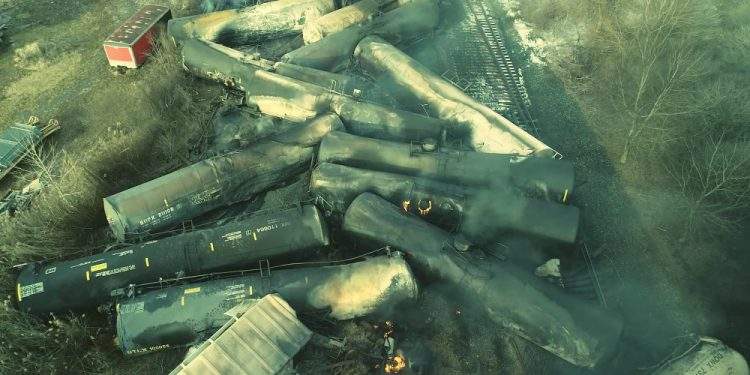The Environmental Protection Agency (EPA) has written the Norfolk Southern Railway describing the chemicals found at the site of a Feb. 3 train derailment and controlled burn in East Palestine, Ohio, that some local residents have linked to sickness or death among animals.
The Feb. 10 letter from the EPA to Norfolk Southern notes “multiple rail cars and tankers were observed derailed, breached, and/or on fire.”
Coverage of the incident has mainly stressed the presence of vinyl chloride, a chemical used to make PVC pipes and other products. The National Cancer Institute notes that vinyl chloride has been linked to cancers of the brain, lungs, blood, lymphatic system, and, in particular, the liver.
Yet, the EPA’s letter mentions other potentially hazardous chemicals in those derailed tankers.
Specifically, it notes the presence of ethylene glycol monobutyl ether, ethylhexyl acrylate, isobutylene, and butyl acrylate.
The National Oceanic and Atmospheric Administration’s online chemical database notes that the chemical solvent ethylene glycol monobutyl ether “can cause serious or permanent injury.”
“Ingestion or skin contact causes headache, nausea, vomiting, dizziness,” the website states regarding the chemical, which is found in many household products.
The same chemical database notes that 2-ethylhexyl acrylate, which is used to make paints and plastics for things like contact lenses, “can cause significant irritation” and may be explosive at high temperatures.
It states that isobutylene, a liquified gas used to make aviation fuel, can incapacitate and, in some circumstances, asphyxiate those exposed to it.
Butyl acrylate, meanwhile, is described in that database as potentially a source of serious or permanent injury and a relatively unstable substance. It is used in making things like paints, sealants, and adhesives.
The Epoch Times has asked the EPA for more detail on the potential environmental and human health risks posed by the chemicals involved in the derailment.
Norfolk Southern Responds
“Norfolk Southern received the EPA’s letter and we have confirmed to them that we have and will continue to perform or finance environmental monitoring and remediation. Our hazmat team was in East Palestine within an hour of the incident, and the response continues today in close coordination with the Ohio and U.S. EPA, NTSB [National Transportation and Safety Board], and other federal, state, and local agencies,” a spokesperson for Norfolk Southern told The Epoch Times in a Feb. 13 email.
The spokesperson directed The Epoch Times to the NTSB for any comments on the causes of the crash.
The latest details from that agency came Feb. 6, through an announcement that it had launched an investigation into the derailment.
“Additional information will be issued when available,” the NTSB told The Epoch Times in a Feb. 13 email.
While some online influencers have said Norfolk Southern paid only $25,000 to the town of East Palestine, the company’s spokesperson said that sum was just an initial donation to the Red Cross to establish a shelter at East Palestine High School.
“In total, more than $1 million has been distributed directly to families to cover costs related to the evacuation,” a Feb. 13 press release from the company states.
EPA’s letter describes Norfolk Southern as potentially liable under the federal government’s Superfund law.
It wouldn’t be the first Norfolk Southern derailment site to end up under that regime.
One derailment in Decatur, Alabama, involved the contaminant hydrofluoric acid, a chemical that can be deadly if inhaled in large quantities.
Local Waterways
The EPA’s letter states that “materials related to the incident” were seen flowing into storm drains.
Chemicals released during the event have also been detected in various local waterways, including the Ohio River, according to the letter.
The Ohio River watershed is home to 25 million people and spans parts of 14 states. The river ultimately empties into the Mississippi River.
West Virginia American Water has not detected any changes to water in portions of the Ohio River that it monitors, as reported by WCHS.
Buttigieg Under Fire
The derailment has provoked strong rhetoric from lawmakers, some of whom have blamed Transportation Secretary Pete Buttigieg, formerly a McKinsey consultant and mayor of a college town in Indiana.
“This is another transportation failure under Mayor Pete’s leadership. Where is he?” asked Rep. Andy Biggs (R-Ariz.) in a Feb. 13 post on Twitter.
Buttigeg did not mention the incident while delivering remarks on Feb. 13 while speaking at the National Association of Counties Legislative Conference.
He did, however, mention the threat from “balloons,” drawing laughter from his audience.
The Epoch Times has reached out to the EPA for additional comment.
What Would You Do If Pharmacies Couldn’t Provide You With Crucial Medications or Antibiotics?
The medication supply chain from China and India is more fragile than ever since Covid. The US is not equipped to handle our pharmaceutical needs. We’ve already seen shortages with antibiotics and other medications in recent months and pharmaceutical challenges are becoming more frequent today.
Our partners at Jase Medical offer a simple solution for Americans to be prepared in case things go south. Their “Jase Case” gives Americans emergency antibiotics they can store away while their “Jase Daily” offers a wide array of prescription drugs to treat the ailments most common to Americans.
They do this through a process that embraces medical freedom. Their secure online form allows board-certified physicians to prescribe the needed drugs. They are then delivered directly to the customer from their pharmacy network. The physicians are available to answer treatment related questions.





